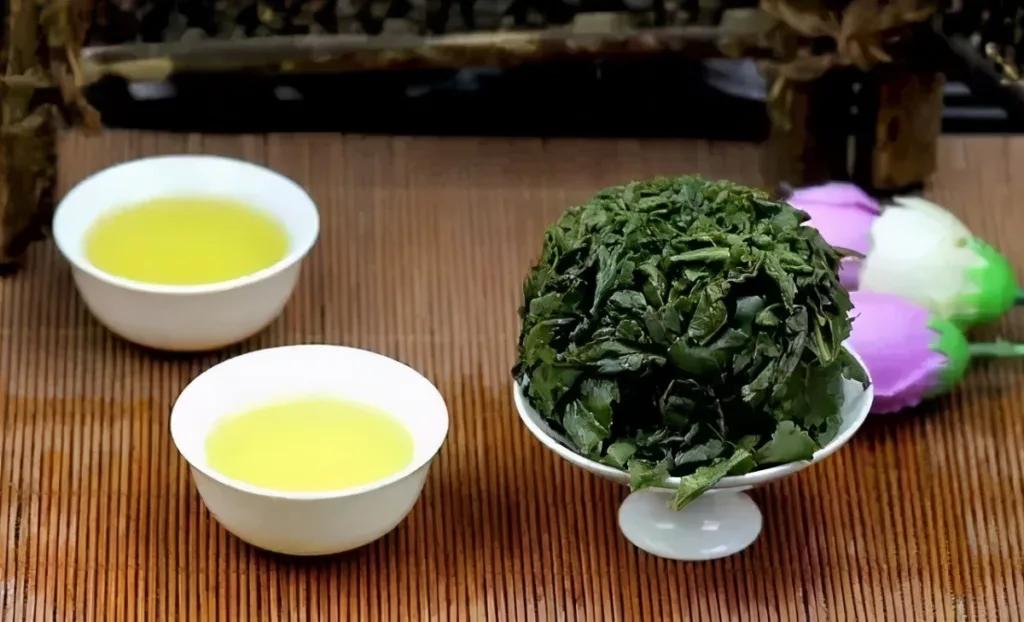Phoenix Shui Xian (凤凰水仙), an exceptional oolong tea, hails from the Phoenix Mountain region in Chao’an County, Guangdong province. It primarily thrives in several areas across Guangdong, including Chao’an, Fengshun, Raoping, Jiaoling, Pingyuan, and beyond. After extensive cultivation post the 1950s, this tea has gained recognition for its unique natural floral aroma, brilliant amber liquor, and rich, refreshing flavor.
Historical Origin
Legend has it that during the late Southern Song Dynasty, Emperor Zhao Bing journeyed through the Chaozhou region and passed by the Wudong Mountain in the Phoenix Mountain area. Feeling thirsty, his attendants plucked tea leaves resembling bird beaks from the local trees and brewed them. The resulting tea quenched his thirst, cured his cough, and had a remarkable effect. Following this discovery, the tea was widely cultivated and became known as “Song Breed,” with a history spanning over 900 years.
Today, Wudong Mountain still hosts tea trees aged 300-400 years, referred to as descendants of the Song Breed tea. The largest of these is named “Daye Xiang,” standing 5-8 meters tall, with a canopy width of 7.3 meters and a stem circumference of 34 centimeters. It boasts five major branches, attesting to its impressive age and heritage.
Brewing Method
The art of brewing Phoenix Shui Xian tea requires careful attention to detail. Follow these steps to brew the perfect cup:
Teaware Selection: Choose a white porcelain lidded bowl (gaiwan) as your primary teaware. Complement it with white porcelain tasting cups and clear glass fairness cups for an exquisite experience.
Teaware Rinse: Once the water has boiled, consecutively rinse your teaware. This not only raises the temperature of the teaware but also enhances the release of the tea’s aroma. It also serves the purpose of cleaning and removing any unwanted odors.
Tea Introduction: Add approximately 8 grams of Phoenix Shui Xian tea to your gaiwan. Cover the gaiwan, gently shake it a few times to distribute the tea leaves evenly, and then uncover to savor the aroma.
Water Infusion: Gradually and evenly pour hot water into the gaiwan at a temperature of 95-100°C. This ensures the tea leaves are thoroughly soaked in hot water. For the first three infusions, a steeping time of 2-3 seconds is recommended. Subsequent infusions can be extended to around five seconds.
Health Benefits
Beyond its captivating flavor and aromatic bouquet, Phoenix Shui Xian tea offers several health benefits that make it not just a beverage but a potential natural remedy:
Digestive Aid and Fat Reduction: Phoenix Shui Xian tea can accelerate the breakdown and metabolism of fats. It also helps remove greasiness from the digestive system while stimulating the secretion of digestive fluids. Consuming this tea after indulging in oily or heavy meals can aid digestion and reduce the accumulation of fatty substances in the body, potentially preventing obesity.
Cholesterol Control: Active compounds in Phoenix Shui Xian tea can expedite the dissolution and metabolism of fat within the body, inhibiting the absorption of cholesterol. This purification of the blood helps reduce cholesterol levels, softens blood vessels, and promotes better blood circulation, contributing to the prevention of high blood pressure and elevated cholesterol levels.
Anti-Aging: Phoenix Shui Xian tea absorbs various natural active compounds. These compounds boost the activity of superoxide dismutase (SOD) within the body, effectively clearing free radicals and reducing oxidative reactions. This results in maintaining a youthful and healthy state, helping to delay various signs of aging.
Weight Management: Phoenix Shui Xian tea possesses fat-dissolving properties due to its primary component, tannic acid, which is closely linked to fat metabolism. This tea can reduce cholesterol levels in the bloodstream. Compared to black and green teas, Phoenix Shui Xian tea, in addition to stimulating the activity of pancreatic fat-digesting enzymes and reducing the absorption of sugar and fat, can also facilitate fat burning and reduce the accumulation of abdominal fat.



